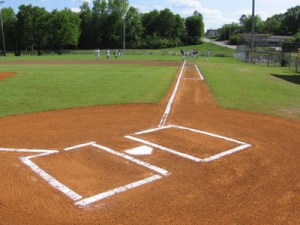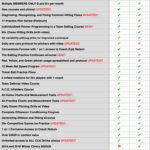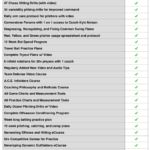Creating challenges for practice
In one of our last posts (and Podcast), we discussed ways to keep practices fun and energetic by using tactical games. Another effective method that will accomplish the same goal while creating pressure is to use a daily skills challenge. We start every day with a specified amount of conditioning at the end of practice (not a huge amount, but enough to motivate). At some point during practice, we select up to four players to participate in a skills challenge. Each time they perform the task successfully we take one rep off the conditioning. For example if they started with twelve “poles” as conditioning, and performed the task correctly eight times, they would only have four “poles” at the end of practice. ***As a side note about running poles, the more traditional long, slow distance poles are probably not very beneficial to baseball players. Poles should be run as short sprints followed by walking or easy jogs, or as a long sprint***
I do not believe in using conditioning as a form of punishment. I believe that it creates resentment, and players begin to view conditioning as a negative experience instead of a tool to make themselves better. Even though these challenges do tie performance to conditioning, it is not in a negative way. Because they start with a specified amount and are able to work them off, this is giving a positive reward for a good performance instead of punishing for a negative performance. You MUST frame it that way to your athletes. When they accomplish the goal set forth, be sure to subtract from the overall level of conditioning. Do not start from zero and add one for every failure.
Sign Up Here For More Great Free Content From Cornerstone
Long tee challenge
Set up a tee at one end of the cage. Their goal is to hit a line drive off the back of the cage. We set the conditioning level at six, 60-yard sprints. Three players get two swings each. Each time they hit a line drive off the back of the cage, we take a sprint away.
Bunting Challenge
Set up cones about four feet off each foul line. Players are to sacrifice bunt between the cones and the foul line. We set the conditioning level at eight “poles.” We take one away for each successful bunt.
Catcher blocking challenge
Draw a circle around home plate in the dirt (approximately 6-8 feet in diameter). Throw balls in the dirt for the catcher to block. Their goal is to block the ball, scramble to their feet and get the ball back in their hands before the ball leaves the circle. Each time they accomplish this goal, take a sprint away.
[wp_ad_camp_3]
Pitcher/Catcher to 2nd base
Pitchers deliver a pitch from the stretch, the catcher receives it and throws to second base. Their goal is for this combined time to be less than 3.5 seconds (at the high school level). We set the conditioning for this particular challenge at ten straight steals. This ties the conditioning to the skill being challenged. Again for each successful try, take a straight steal away.
With this challenge, be careful that your players don't "cheat" by not using proper mechanics on the mound or by jumping out early behind the plate. If they cheat, count it as an unsuccessful try.
General advice
As I mentioned earlier, I do not like to use conditioning as punishment, but the reality is that baseball players do need conditioning. We have simply allowed our players to decrease the amount of conditioning by accomplishing skills that we deem important.
I recommend having the whole team around watching the challenge. This increases the intensity and helps your players learn to perform in pressure situations. Also, feel free change the level of success in your individual challenges. Ideally, you would like the challenges to be difficult, but attainable. A quality challenge will allow the players to reduce their conditioning by about a half.
Our podcast to be released on 12/23 gives an in depth description of how we maximize our practice time with a large roster and very limited facility.
 Posted by Kyle Nelson
Posted by Kyle Nelson- Posted in Practice Organization
 Mar, 03, 2013
Mar, 03, 2013 No Comments.
No Comments.
Elite members login here
Check out what’s New/Hot!
Recognizing, Diagnosing, and Fixing Common Hitting Flaws eCourse The 3 metrics we tested on Blast motion sensors this year Sneak Peek Inside an Elite Q and A The batting practice continuum Elite Member’s area table of contents 50+ “Chaos” hitting drills
5 sample Chaos hitting drills FREE
Mental Skills and Culture Building The hitting pyramid Welcome Elite Member, Trey! Ideas for a pitcher first practice 12 week bat speed improvement plan Make plans this offseason to have your team playing their best baseball at the end of the year” Top 5 hitting drills to translate practice skill to game performanceHow we used Blast Motion sensors with a team in 2019
What to do if your hitters are overmatched Welcome Elite Member, Tommy! Setting your baserunners up for success Welcome Elite Member, Mike! A consulting call with Elite Member Matt FREE Web Clinic: Developing Athletic, Consistent, Extraordinary Infielders
 Coach Kyle Nelson
Coach Kyle Nelson





